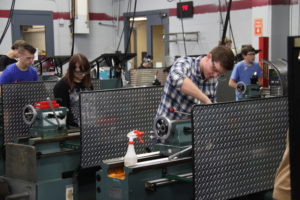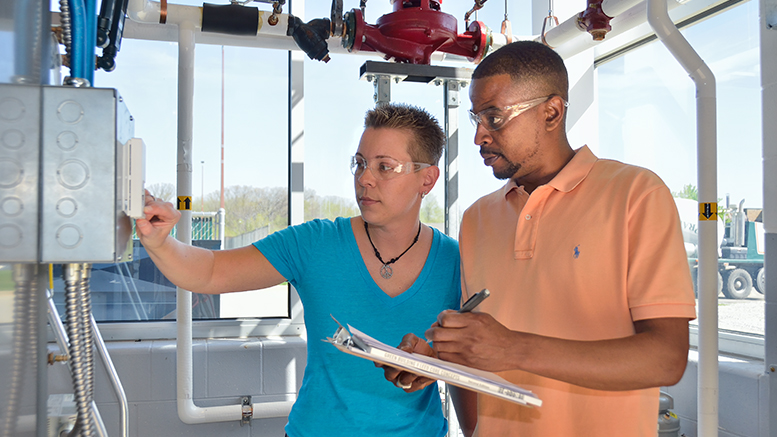The announcement that Taiwanese manufacturing giant Foxconn will bring 13,000 jobs to Wisconsin and partner with Gateway Technical College is great news for the state’s community and technical colleges and their students, but it’s not particularly surprising.
The state’s two-year colleges have been notching all sorts of workforce development victories in recent years, offering an array of programming in advanced manufacturing, healthcare, automotive and other fields that provide family-wage jobs for graduates and/or pathways to four-year universities, at rates often exceeding 90 percent within months after graduation.
The Wisconsin Technical College System (WTCS) takes seriously its statutory mission and to meet employer needs and build a talent pipeline, to serve both students and employers as its two primarily clients, says Morna Foy, system president.
“You have to have that expectation if you want something to be sustained, regardless of turnover within the organization,” she says.
Gateway, which serves three counties in southeast Wisconsin and was founded a century ago to help transition the community to a then-new industrial society, is now easing the next transition to a digital society, with companies like Foxconn driving the conversation, President Bryan Albrecht says.
“Foxconn has been a great asset to us in helping us to understand the role that community and technical colleges will play, but also the types of content and curriculum that will be necessary to sustain a workforce,” Albrecht says. “We continue to work hand-in-glove with them to not only address the recruitment of new talent but also the upscaling of current talent.”
Gateway and other Wisconsin colleges are rolling out training based on Industry 4.0 protocol, which revolves around the “Internet of Things,” Albrecht says. “It’s how we take the digital world and connect it to the physical world, and make sure that our students have great technical skills — programming robots and fixing robots and building integrated manufacturing systems, but also having the ability to analyze data, to troubleshoot, to be critical thinkers.”
The state has put together a consortium of two-year colleges and four-year universities to determine how to build career pathways starting in K–12 districts.
“We develop that area of pathways so there’s a smooth transition for students because we know there are job expectations at all those levels,” Albrecht says. “We work with all of the regional providers of higher education to make sure that we’re providing, first of all, the right curriculum, and then second, that that curriculum is ‘pathwayed’ into advanced careers.”
This excerpt comes from the current issue of the American Association of Community Colleges’ Community College Journal.
Kaylen Betzig, president of Waukesha County Technical College (WCTC), believes her college and others benefit from the state’s model of governance with both a state board as well as a local board for each college. The local board, appointed by the county chairperson, is required to have nine individuals from different workforce sectors. “We have business professionals, I have a sheriff, I have a superintendent of schools, a school board member, bankers, insurance people, regional economic development people,” Betzig says. “The strength is in our local boards because they really bring us the local perspective of what our employers are needing.”

Waukesha County Technical College’s workforce programs are developed with research and employer partnerships. (Photo: WCTC)
Milwaukee Area Technical College (MATC), which has four campuses, keeps hearing from employers concerned about “skills-gap mismatch,” President Vicki Martin says. “Almost every [industry] area is telling us they’re looking for better-trained employees,” she says. “They’re also talking about soft skills — they would rather have somebody with a good work history and train them in the skills. We’re also reaching out to our high schools in terms of those soft skills.”
But with the strong economy, many traditional college-aged students think they would be better off getting into the workforce, even with fewer skills, Martin says. “That gives a lot of employers heartburn,” she says. “They’re like, ‘Oh my gosh, they’re over there, and they could be over here earning family-sustaining wages [with additional skills].’”
Reorganizing to meet employer need
To help employers navigate its offerings, Madison College has reorganized its programs into a new School of Workforce and Economic Development, merging continuing education and business and industry training under one umbrella, Provost Turina Bakken says.
“The leadership team is much more coordinated in terms of doing employer outreach, grassroots needs analysis and partnership building,” she says.
“We’re sitting at the table and can better understand and respond at the speed of business,” says Schauna Rasmussen, dean of the newly organized school. “What are their pain points, when it comes to hiring? How do we make connections so we’re doing training that meets their needs?”
Madison College built an internal academic analysis unit to analyze data in terms of industry growth, and where gaps in credentials lie, Bakken says. “Then they overlay that with our own academic offerings,” she says. The college has built more “modularized” offerings so students can gain a credential, work for awhile and then return to build on that credential, she adds.
Because so many programs are capital equipment and technology heavy, Madison works to stay one step ahead of industry, sometimes utilizing grants to get the equipment.
“We try to invest at a very high level,” Rasmussen says. “We’ve gotten pretty creative at making sure that especially our high-tech, high-capital-intensive programs have what they need.”
Read the full article online.

